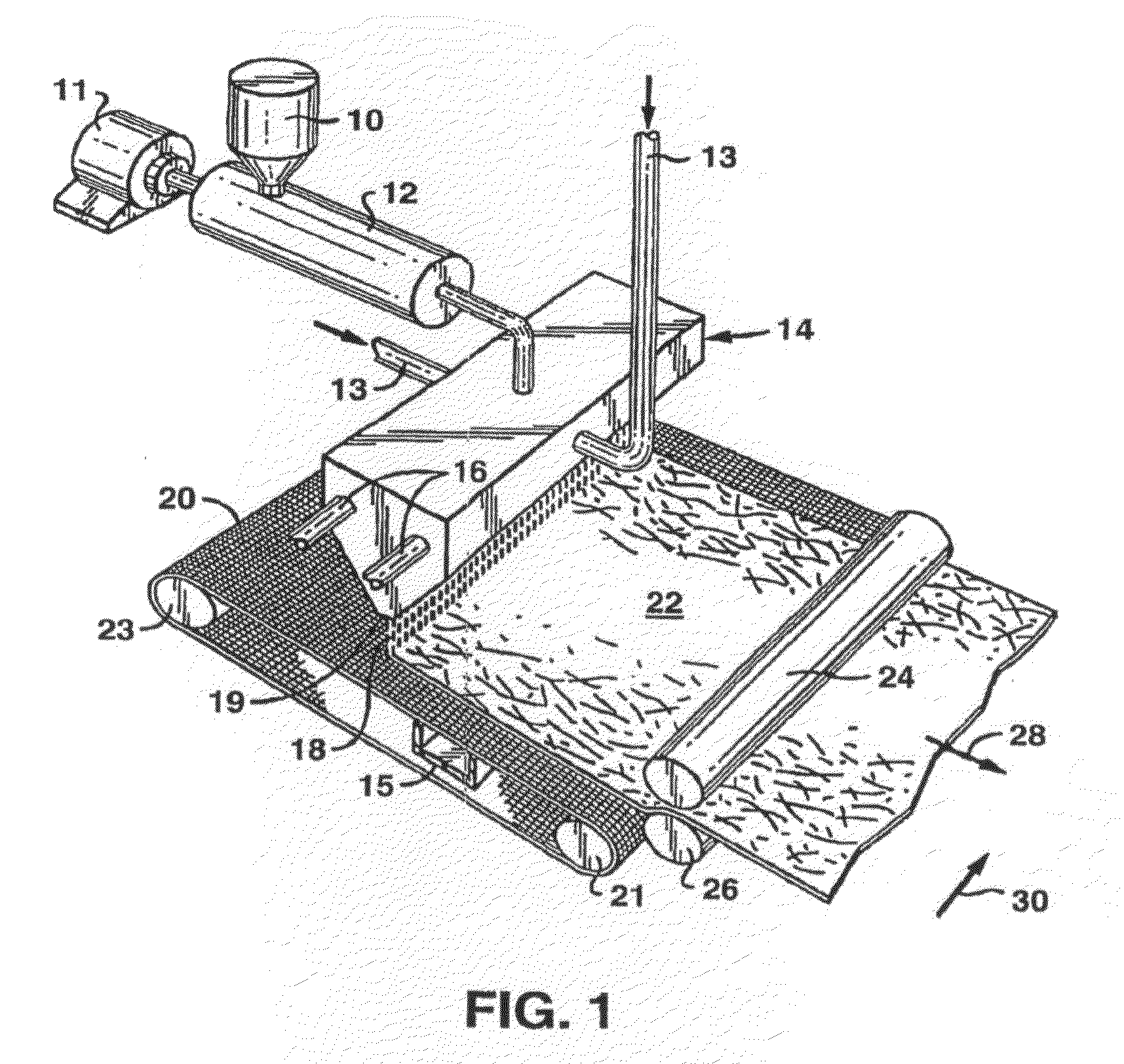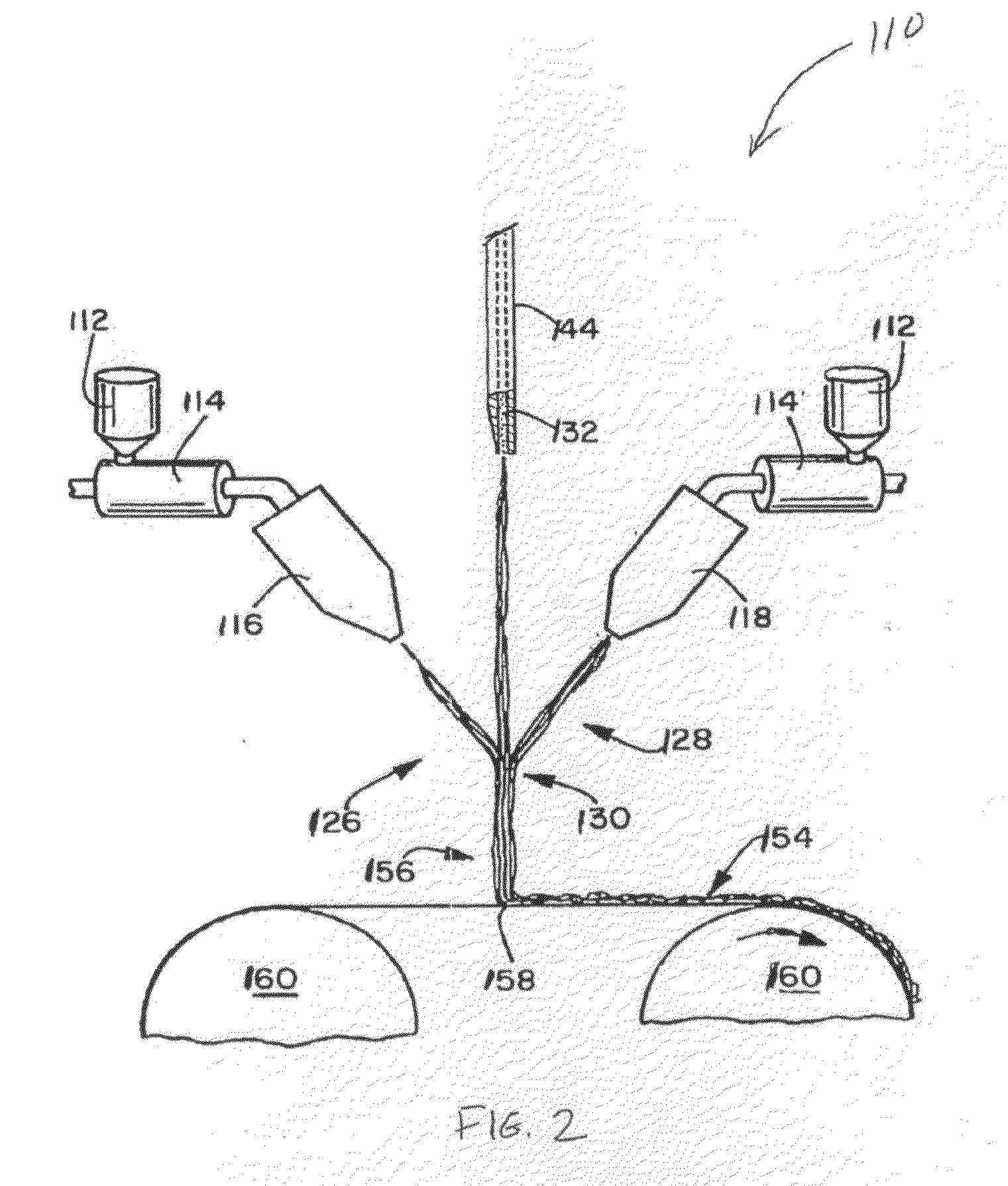Biodegradable polylactic acids for use in forming fibers
a technology of biodegradable polylactic acids and fibers, which is applied in the direction of weaving, filament/thread forming, layered products, etc., can solve the problem that conventional polylactic acids are not typically suitable for meltblowing processes
- Summary
- Abstract
- Description
- Claims
- Application Information
AI Technical Summary
Problems solved by technology
Method used
Image
Examples
example 1
[0085]Two grades of polylactic acid (PLA) polymer resins were employed, i.e., 6201D supplied by NatureWorks LLC (Minnetonka, Minn.) and L9000 supplied by Biomer Inc. (Germany). Resins were formed as described below in Table 1 and melt processed using a Wernerer Phleiderer Model ZSK-30 twin screw extruder (L / D ratio of 44). Three extruder screw configurations were utilized during the experiments specified as Low, Medium, and High screw shear settings. The low shear screw setting included a total of 33 low shear conveying elements and a total of 20 high shear kneading elements. The medium shear screw setting included a total of 29 low shear conveying elements and a total of 25 high shear kneading elements. The high shear screw setting included a total of 19 low shear conveying elements and a total of 39 high shear kneading elements. After extrusion, the modified polymer strands were cooled on a conveyor belt and pelletized. Resins were used both dry and pre-moisturized. Moisture conte...
example 2
[0087]Several of the pellet samples of Example 1 were subjected to varying drying conditions to test the resulting effect on the final melt flow rate (MFR). The final melt flow rate was tested. The drying conditions and test results are set forth below in Table 4.
TABLE 4Properties of Dried ResinsFinalMoistureFinal MFR,AdditveDryingContent190° C.% MFRSamplePolymerAdditive(wt. %)conditions(ppm)(g / 10 min)Reduction13PLA 6201DNone—84248—180° F., 24 hours30039.617.3315PLA 6201DPEG 800015—1053129—180° F., 24 hours196124 3.95180° F., 48 hours227129 0.0019PLA 6201DPEG 60010—89798—180° F., 24 hours17184.214.0835PLA 6201DPEG 800015—1477156—120° F., 24 hours247119.723.2736PLA 6201DPEG 800015—1416194—130° F., 72 hours40316813.40
[0088]As indicated, some reduction in melt flow rate was indicated after drying.
example 3
[0089]Meltblown webs were formed from three (3) different resin samples on conventional meltblown equipment, such as described above. Sample A was formed from the resin of Sample No. 38 (Example 1) and was extruded as a monocomponent fiber. The resin was dried overnight at 180° F. before wet processing. Sample B was also formed from the dried resin of Sample No. 38 (Example 1). However, Sample B was extruded in a general sheath / core configuration in which the core (80 wt. %) was formed from the resin of Sample No. 38 and the sheath (20 wt. %) was formed from a polypropylene resin available under the designation “PF015” from Basell North America, Inc. (Elkton, Md.). A control meltblown web was also formed that contained the PF015 polypropylene as a monocomponent fiber. The conditions for forming the meltblown webs are set forth below in Table 5. Further, various mechanical properties of the webs are set forth below in Table 6.
TABLE 5Meltblown Web Processing ConditionsSampleControlABE...
PUM
| Property | Measurement | Unit |
|---|---|---|
| temperature | aaaaa | aaaaa |
| temperature | aaaaa | aaaaa |
| temperature | aaaaa | aaaaa |
Abstract
Description
Claims
Application Information
 Login to View More
Login to View More - R&D
- Intellectual Property
- Life Sciences
- Materials
- Tech Scout
- Unparalleled Data Quality
- Higher Quality Content
- 60% Fewer Hallucinations
Browse by: Latest US Patents, China's latest patents, Technical Efficacy Thesaurus, Application Domain, Technology Topic, Popular Technical Reports.
© 2025 PatSnap. All rights reserved.Legal|Privacy policy|Modern Slavery Act Transparency Statement|Sitemap|About US| Contact US: help@patsnap.com



